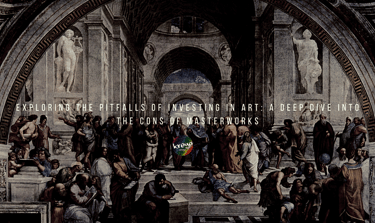Exploring the Pitfalls of Investing in Art: A Deep Dive into the Cons of Masterworks
In this in-depth exploration, we delve into Section 2 of the Masterworks model, focusing on the cons that potential investors should be acutely aware of before venturing into the world of art investment.
ART


In recent years, the world of investing has seen a unique intersection with the art world through platforms like Masterworks. While the allure of investing in masterpiece artworks might seem irresistible, it's crucial to approach this investment avenue with caution. In this in-depth exploration, we delve into Section 2 of the Masterworks model, focusing on the cons that potential investors should be acutely aware of before venturing into the world of art investment.
1. Illiquidity: The Art of Waiting
At first glance, the idea of owning a piece of art that could appreciate in value over time is appealing. However, one of the most significant drawbacks of investing in art is its inherent illiquidity. Unlike traditional financial assets, art assets are not easily converted into cash. The process of selling an artwork can be a complex and time-consuming endeavor.
Imagine you've invested a substantial amount in a coveted painting through Masterworks. While the potential for a handsome return exists, the journey to access those funds might be much longer than anticipated. The art market operates at a different pace than stock or bond markets. Finding a suitable buyer, navigating the negotiation process, and dealing with the intricacies of art transactions can extend the selling timeline.
For investors who might require quick access to funds due to unforeseen circumstances, this illiquidity could prove problematic. It's essential to weigh the potential returns against the possibility of having your capital tied up for an extended period.
2. Market Volatility: Brushing Against Uncertainty
Investing in art, like any other market, involves a degree of uncertainty. The art market is notorious for its volatility, with artworks experiencing fluctuations in value that can be as unpredictable as the brushstrokes on a canvas. While some pieces may appreciate significantly and deliver handsome returns, others might not perform as expected, leaving investors with disappointing outcomes.
Consider a scenario where an artwork you've invested in suddenly falls out of favor with collectors and art enthusiasts. This could be due to changes in artistic trends, shifts in consumer preferences, or even scandals surrounding the artist. Such incidents can lead to drastic drops in the value of the artwork, potentially eroding the investment returns you had initially anticipated.
Investors need to recognize that the value of artworks is influenced by a multitude of factors beyond their control. Economic downturns, geopolitical events, and changes in cultural sentiment can all contribute to market fluctuations. As such, the perceived stability of art investments can be deceptive, and investors should be prepared for the possibility of both gains and losses.
3. Limited Control: The Art of Hands-Off Investing
One of the advantages of investing directly in stocks or real estate is the level of control investors have over their assets. Unfortunately, when it comes to Masterworks and similar platforms, investors relinquish a significant degree of control over the artworks they invest in. While the platform promises to handle the management of the artworks, this can mean limited input from investors on critical decisions.
Imagine having a passionate belief in the potential of a specific artwork to appreciate in value. In traditional investments, you might be able to actively influence the asset's trajectory through strategic decisions. However, with Masterworks, decisions related to sales, exhibitions, and valuations are largely in the hands of the platform's management.
This lack of control can be frustrating for investors who want to play a more active role in managing their investments. It's essential to understand that while Masterworks aims to make informed decisions, these decisions might not always align with your personal investment philosophy.
4. Fees and Costs: The Price of Art Investment
As with any investment vehicle, investing in art through platforms like Masterworks comes with its fair share of fees and costs. While these fees might seem inconspicuous at first, they can significantly impact the overall returns investors realize from their art investments.
Masterworks charges several types of fees, including management fees and performance-based fees. Management fees cover the costs associated with the platform's operations, including research, acquisition, and ongoing management of artworks. Performance-based fees, on the other hand, are charged when an artwork is sold and typically take a percentage of the profits generated.
For instance, let's say you've invested in a painting that appreciates in value and is eventually sold for a handsome profit. While the gain might appear substantial, the performance-based fees can eat into a significant portion of that profit, reducing the final return you receive.
Investors must carefully consider these fees and costs when evaluating the potential returns of their investments. What might seem like a lucrative opportunity could become less appealing once the impact of fees is factored in.
Conclusion: Navigating the Art of Art Investment
Investing in art through platforms like Masterworks presents a unique opportunity to diversify one's investment portfolio and potentially benefit from the appreciation of masterpiece artworks. However, it's vital to approach this avenue with a clear understanding of the cons associated with it.
The illiquidity of art assets, the market's inherent volatility, limited control over investment decisions, and the impact of fees and costs are factors that can significantly influence the overall outcome of art investments. As with any investment, due diligence and a comprehensive assessment of risk and reward are essential.
Before embarking on an art investment journey through platforms like Masterworks, investors should carefully weigh these cons against the potential benefits. While the allure of owning a piece of artistic history is undeniable, it's crucial to make informed decisions that align with your financial goals and risk tolerance. Just as an artist meticulously crafts each stroke on a canvas, investors must craft their investment strategies with precision and foresight.


